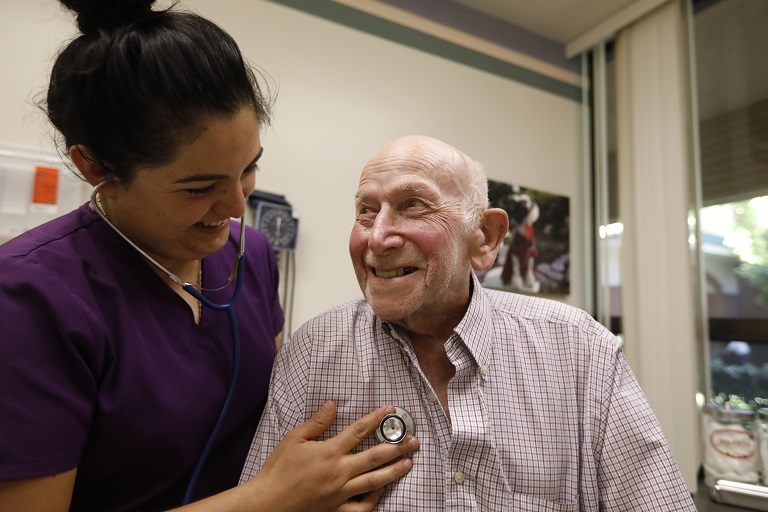Hospice, Hospice Partners, and Telehealth in the Time of COVID-19
CMS clarified in their interim final rule that for telehealth services a “telecommunications system” would mean “multimedia communications equipment that includes, at a minimum, audio and video equipment permitting two-way, real-time interactive communication between the patient and distant site physician or practitioner.” Non-HIPAA compliant platforms like FaceTime and Skype can be used via a smartphone during the emergency under this definition; but there must be an audio-video connection.
Flexibilities for Hospices and Recommendations for Collaboration
Prior to the public health emergency caused by COVID-19, hospice providers could augment their services with telephone calls or telehealth but could not count these services as visits on the plan of care. The exception to this was that social workers can and continue to be able explicitly to make phone calls to patients and families and record those phone calls as visits on the hospice claim form.
For the duration of the public health emergency, the following changes have been made:
- The face to face recertification which occurs for hospice patients who have been on service for 180 days can be done via telehealth as well. This visit cannot be audio only – it must be a “face to face” (i.e. done via device with audio-visual capability).
- Hospices can perform all visits at the routine home care level of care via technology – meaning using telehealth or using audio only when appropriate. Hospices will still need to document that they met the plan of care effectively. CMS has particularly emphasized this point for specific visits – like the initial assessment, the comprehensive assessment, and the two week supervisory visit by a nurse. Hospices can utilize technology for these visits but need to be sure that they are collecting all of the information needed to truly assess the patient which may require an in-person visit by at least one member of the interdisciplinary team.
We have gotten a lot of questions from across the membership about these visits, particularly the initial assessment, and whether hospices can do them via technology.
- Our current understanding is that hospices can utilize technology for all routine home care visits. However, hospice providers really need to be able to assess the patient to establish a relationship and make sure they can really get a sense of the patient’s conditions and needs (and any family or caregivers).
- We encourage you to work with your hospice partners on how to make in-person visits available when they are needed. Hospice providers are essential healthcare workers and should be able to enter communities if they are properly screened — please refer to our flowchart tool for guidance on screening procedures for hospice workers.
- Some strategies could include but are not limited to:
- grouping hospice personnel visits so they occur only on certain days;
- trying to use the same professional in each setting (i.e. making sure the same nurse and aide are always going to a specific facility or community);
- creating a joint strategy including how to time the visits (i.e. having the hospice nurse come in and use telehealth to incorporate the rest of the hospice interdisciplinary team) and how to get patients the telehealth equipment that may enhance the ability to use audio visual connections. We have heard of communities and hospices asking for donations of old smartphones or tablets.
- Some strategies could include but are not limited to:
- Remember that hospice organizations can be utilized to augment other services; one good example would be partnering with hospices on advance care planning and other conversations around shared-decision-making in the time of COVID-19.
- Telehealth visits should be documented the same as in-person visits and in the chart the hospice should note that the service was done via telehealth. While only in-person visits can be reported on the hospice claim, CMS is open to feedback from members on CMS including such visits in the future on hospice claims for informational purposes. This would require changes to hospices’ billing software, and we want to be cognizant of the burden when such information would not be used for payment purposes.
Please email Mollie Gurian, Director of Hospice, Palliative and Home Health Policy if you have thoughts on the documentation issue or other questions.

Most Recommended
October 15, 2025
 Shutdown Week Three: Impact of Ongoing Closure on Affordable Housing
Shutdown Week Three: Impact of Ongoing Closure on Affordable Housing
December 10, 2025
Fiscal Year (FY) Funding 2026
October 07, 2025
Immigrant Workforce Matching Program Brings Workforce Relief
Recently Added
December 19, 2025
House Moves Forward on Affordable Housing Reforms
December 19, 2025
White House Cannabis EO Paves Way for Research, Access
December 19, 2025
LeadingAge Urges DHS to Maintain "Public Charge" Guardrails
December 18, 2025



